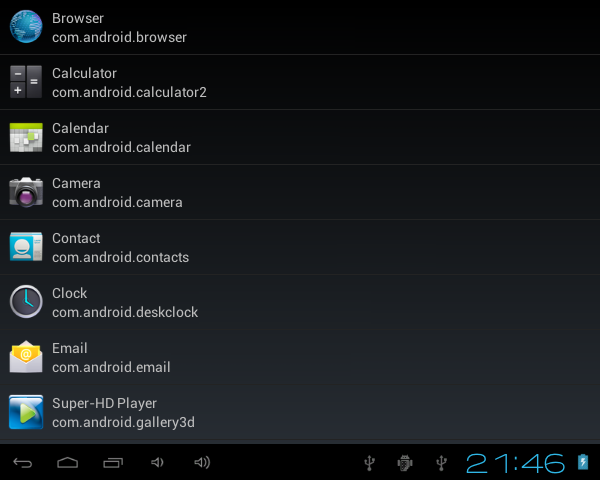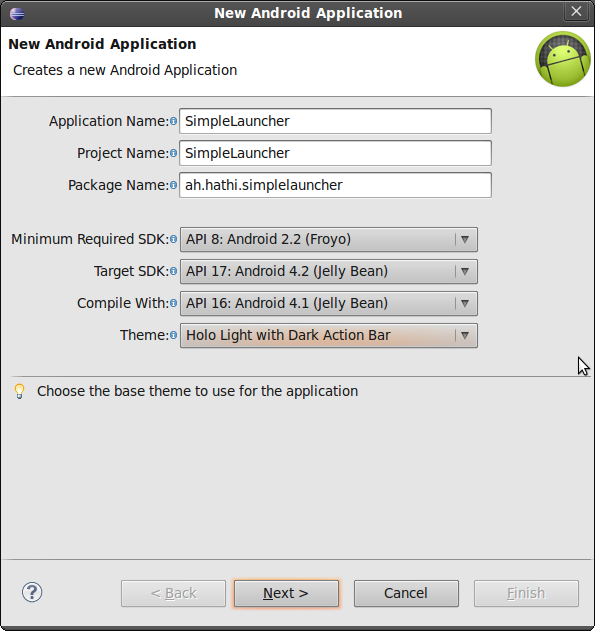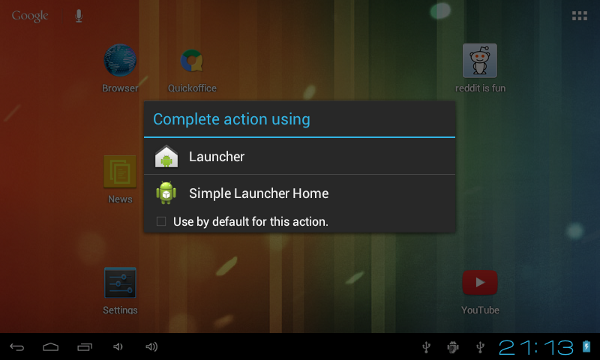
Introduction
In its most basic form, a launcher is an application that does the following:
- it represents the home screen of a device
- it lists and launches applications that are installed on the device
In other words, it is the application that shows up when you press the home button. Unless you've already installed a custom launcher, you are currently using the default launcher that comes with your Android installation. A lot of device manufacturers have their own default, custom launchers that conform to their proprietary look and feel, for example, Samsung TouchWiz and HTC Sense.
In this tutorial, we are going to create a simple launcher with a basic user interface. It will have two screens:
- a home screen showing the device's wallpaper
- a screen showing the icons and details of the applications installed on the device
By the way, if you work a lot with Android, you may want to check out one of the 1,000+ Android app templates on Envato Market. There's a huge variety, so you're sure to find something there to help you with your work. Or you could outsource areas that aren't your speciality by hiring an app developer or designer on Envato Studio.

1. Requirements
You need to have the following installed and configured on your development machine:
- Android SDK and platform tools
- Eclipse IDE 3.7.2 or higher with the ADT plugin
- an emulator or Android device running Android 2.2 or higher
You can download the SDK and platform tools the Android developer portal.
2. Project Setup
Launch Eclipse and create a new Android application project. I'm naming the application SimpleLauncher, but you can name it anything you want. Make sure you use a unique package. The lowest SDK version our launcher supports is Froyo and the target SDK is Jelly Bean.

Since we don't want to create an Activity, deselect Create Activity. Click Finish to continue.

3. Project Manifest
The next step is modifying the AndroidManifest.xml file by adding two activities. The first Activity displays the home screen. Let's name it HomeActivity as shown below.
<activity
android:name="ah.hathi.simplelauncher.HomeActivity"
android:label="Simple Launcher Home"
android:theme="@android:style/Theme.Wallpaper.NoTitleBar.Fullscreen"
android:launchMode="singleTask"
android:stateNotNeeded="true"
>
<intent-filter>
<action android:name="android.intent.action.MAIN" />
<category android:name="android.intent.category.HOME" />
<category android:name="android.intent.category.DEFAULT" />
</intent-filter>
</activity>
By adding the categories android.intent.category.HOME and android.intent.category.DEFAULT to the intent-filter group, the associated Activity behaves like a launcher and shows up as an option when you press the device's home button.
We also need to set the launchMode to singleTask to make sure that only one instance of this Activity is held by the system at any time. To show the user's wallpaper, set the theme to Theme.Wallpaper.NoTitleBar.FullScreen.
The second Activity we need to add displays the applications that are installed on the user's device. It's also responsible for launching applications. We don't need any special configuration for this Activity. Name it AppsListActivity.
<activity
android:name="ah.hathi.simplelauncher.AppsListActivity"
android:theme="@android:style/Theme.NoTitleBar.Fullscreen"
>
</activity>
4. Activity Layouts
Create an XML file for the HomeActivity class in the project's res/layout folder and name it activity_home.xml. The layout has a single Button that responds to click events. Clicking the button takes the user from the home screen to the list of applications.
<RelativeLayout xmlns:android="http://schemas.android.com/apk/res/android"
xmlns:tools="http://schemas.android.com/tools"
android:layout_width="match_parent"
android:layout_height="match_parent"
tools:context=".HomeActivity" >
<Button
android:id="@+id/apps_button"
android:layout_width="wrap_content"
android:layout_height="wrap_content"
android:layout_alignParentRight="true"
android:layout_alignParentTop="true"
android:layout_marginRight="10dp"
android:layout_marginTop="10dp"
android:text="Show Apps"
android:onClick="showApps"
/>
</RelativeLayout>
Next, create an XML file for the AppsListActivity class in the project's res/layout folder and name it activity_apps_list.xml. The layout contains a ListView that takes up the entire screen.
<?xml version="1.0" encoding="utf-8"?>
<LinearLayout xmlns:android="http://schemas.android.com/apk/res/android"
android:layout_width="match_parent"
android:layout_height="match_parent"
android:orientation="vertical" >
<ListView
android:id="@+id/apps_list"
android:layout_width="match_parent"
android:layout_height="match_parent"
>
</ListView>
</LinearLayout>
Finally, create a third XML file in the same location and name it list_item.xml. This file defines the layout of an item in the ListView. Each list view item represents an application installed on the user's device. It shows the application's icon, label, and package name. We display the application icon using an ImageView instance and TextView instances for the label and package name.
<?xml version="1.0" encoding="utf-8"?>
<RelativeLayout xmlns:android="http://schemas.android.com/apk/res/android"
android:layout_width="match_parent"
android:layout_height="match_parent"
android:padding="10dp"
>
<ImageView
android:id="@+id/item_app_icon"
android:layout_width="wrap_content"
android:layout_height="wrap_content"
android:layout_alignParentLeft="true"
android:layout_centerVertical="true"
/>
<TextView
android:id="@+id/item_app_label"
android:layout_width="wrap_content"
android:layout_height="wrap_content"
android:layout_toRightOf="@+id/item_app_icon"
android:paddingLeft="10dp"
/>
<TextView
android:id="@+id/item_app_name"
android:layout_width="wrap_content"
android:layout_height="wrap_content"
android:layout_below="@+id/item_app_label"
android:layout_toRightOf="@+id/item_app_icon"
android:paddingLeft="10dp"
/>
</RelativeLayout>
5. Implementing the Activity Classes
HomeActivity
With the layouts of the application created, it's time to create the two Activity classes. When creating the two classes, make sure the name of each class matches the one you specified in the project's manifest file earlier.
Create a new class named HomeActivity and set android.app.Activity as its superclass.
package ah.hathi.simplelauncher;
import android.app.Activity;
import android.content.Intent;
import android.os.Bundle;
import android.view.View;
public class HomeActivity extends Activity {
@Override
protected void onCreate(Bundle savedInstanceState) {
super.onCreate(savedInstanceState);
setContentView(R.layout.activity_home);
}
public void showApps(View v){
Intent i = new Intent(this, AppsListActivity.class);
startActivity(i);
}
}
In the class's onCreate method, we invoke setContentView, passing in the layout we created earlier. You may remember that we added a button to the activity_home layout that triggers a method named showApps. We now need to implement that method in the HomeActivity class. The implementation is pretty simple, we create an Intent for the AppsListActivity class and start it.
AppsListActivity
Create another Activity class named AppsListActivity and set android.app.Activity as its superclass. In the class's onCreate method, we invoke setContentView, passing in the activity_apps_list layout we created earlier.
package ah.hathi.simplelauncher;
import android.app.Activity;
import android.content.Intent;
import android.os.Bundle;
import android.view.View;
public class AppsListActivity extends Activity {
@Override
protected void onCreate(Bundle savedInstanceState) {
super.onCreate(savedInstanceState);
setContentView(R.layout.activity_apps_list);
}
}
Even though our launcher isn't finished yet, you can save and run your application at this point. When you press the device's home button, you should see a pop-up asking you which launcher you'd like to use.

If you choose Simple Launcher Home, you should see your new home screen with a single button in the top right corner of the screen. You should also see your device's current wallpaper.

Go back to Eclipse and create a class named AppDetail that will contain the details of an application, its package name, label, and application icon. The interface is pretty basic as you can see below.
package ah.hathi.simplelauncher;
import android.graphics.drawable.Drawable;
public class AppDetail {
CharSequence label;
CharSequence name;
Drawable icon;
}
6. Fetching Applications
In the loadApps method of the AppsListActivity class, we use the queryIntentActivities method of the PackageManager class to fetch all the Intents that have a category of Intent.CATEGORY_LAUNCHER. The query returns a list of the applications that can be launched by a launcher. We loop through the results of the query and add each item to a list named apps. Take a look at the following code snippet for clarification.
private PackageManager manager;
private List<AppDetail> apps;
private void loadApps(){
manager = getPackageManager();
apps = new ArrayList<AppDetail>();
Intent i = new Intent(Intent.ACTION_MAIN, null);
i.addCategory(Intent.CATEGORY_LAUNCHER);
List<ResolveInfo> availableActivities = manager.queryIntentActivities(i, 0);
for(ResolveInfo ri:availableActivities){
AppDetail app = new AppDetail();
app.label = ri.loadLabel(manager);
app.name = ri.activityInfo.packageName;
app.icon = ri.activityInfo.loadIcon(manager);
apps.add(app);
}
}
7. Displaying the List of Applications
With the apps variable containing all the details we need, we can show the list of applications using the ListView class. We create a simple ArrayAdapter and override its getView method to render the list's items. We then associate the ListView with the adapter.
private ListView list;
private void loadListView(){
list = (ListView)findViewById(R.id.apps_list);
ArrayAdapter<AppDetail> adapter = new ArrayAdapter<AppDetail>(this,
R.layout.list_item,
apps) {
@Override
public View getView(int position, View convertView, ViewGroup parent) {
if(convertView == null){
convertView = getLayoutInflater().inflate(R.layout.list_item, null);
}
ImageView appIcon = (ImageView)convertView.findViewById(R.id.item_app_icon);
appIcon.setImageDrawable(apps.get(position).icon);
TextView appLabel = (TextView)convertView.findViewById(R.id.item_app_label);
appLabel.setText(apps.get(position).label);
TextView appName = (TextView)convertView.findViewById(R.id.item_app_name);
appName.setText(apps.get(position).name);
return convertView;
}
};
list.setAdapter(adapter);
}
8. Listening for Clicks
When the user clicks an item in the ListView, the corresponding application should be launched by our launcher. We use the getLaunchIntentForPackage method of the PackageManager class to create an Intent with which we start the application. Take a look at the following code snippet.
private void addClickListener(){
list.setOnItemClickListener(new AdapterView.OnItemClickListener() {
@Override
public void onItemClick(AdapterView<?> av, View v, int pos,
long id) {
Intent i = manager.getLaunchIntentForPackage(apps.get(pos).name.toString());
AppsListActivity.this.startActivity(i);
}
});
}
9. Putting It All Together
To make everything work together, we need to invoke loadApps, loadListView, and addClickListener in the onCreate method of the AppsListActivity class as shown below.
protected void onCreate(Bundle savedInstanceState) {
super.onCreate(savedInstanceState);
setContentView(R.layout.activity_apps_list);
loadApps();
loadListView();
addClickListener();
}
Build and run your application once more to see the result. You should now be able to see the applications that can be launched when you click the button on the home screen of our launcher. Click on an item to launch the corresponding application.

Conclusion
You now have your own custom launcher. It's very basic, but you can add all the customizations you want. If you want to dig deeper into custom launchers, I encourage you to take a look at the sample applications on the Android Developer Portal.


Comments